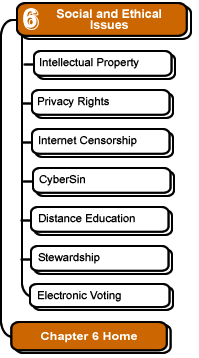

Electronic Voting:
Do the Costs Outweigh the Benefits?
The Six Commandments of Electronic Voting I. Thou shalt keep each voter's choices an inviolable secret. II. Thou shalt allow each eligible voter to vote only once, and only for those offices for which she is authorized to cast a vote. III. Thou shalt not permit tampering with thy voting system, nor the exchange of gold for votes. IV. Thou shalt report all votes accurately. V. Thy voting system shall remain operable throughout each election. VI. Thou shalt keep an audit trail to detect sins against Commandments II–IV, but thy audit trail shall not violate Commandment I. Michael
Ian Shamos, "Electronic Voting—Evaluating the Threat" |
People tend to believe that information technology can provide a solution for most difficult problems. While IT has indeed helped to address a number of problems in telecommunications and information systems, we would do well to consider carefully the costs as well as the benefits of any new technological solution.
Electronic voting systems are one good example to consider. The difficulty of supporting a nation-wide election in a large democracy, such as India or the United States, are well-known. The goals, or "commandments," of electronic voting listed above are actually goals of any election, electronic or otherwise. Votes must be private, each person should be allowed to vote exactly once, and so forth.
Note: More information on electronic voting can be found at Wikipedia (http://en.wikipedia.org/wiki/Electronic_voting).
Technological support for voting has, in fact, been around for some time, but the difficulties that arose in the counting of votes in the U.S. presidential election of 2000 gave rise to calls for more electronic automation. For instance, the problems voters had in understanding the so-called butterfly ballots and the problems election officials had in counting the often mangled paper votes gave rise for calls to adopt electronic voting systems. These systems would provide an easy to use touch-screen interface and would store and count votes electronically.
The more one understands
about the weaknesses of information technology, however, the more questions
one is likely to have about the potential for fully-electronic voting.
Will everyone really find the user interfaces easier to use than the old paper ballots? Will we be able to achieve all six goals of voting? In particular,
will we be able to keep votes private, prevent tampering with the vote
tallies, and ensure that the machines operate properly throughout the
election?
There have been numerous
political initiatives to install electronic voting machines since the
2000 election, and though some have worked properly, many of them have
experienced difficulties of various kinds. We could review the list of
these difficulties, but few of them will truly be surprises. There have
been system failures, flaky behavior of various kinds, and in a large
number of cases the election
authorities ended up decertifying the electronic machines.
This is not to say
that electronic voting systems do not and never will work. They have worked
in a number of cases and will likely become more and more common. India,
for example, uses an automated system of this sort. Neither should we
ignore the difficulties posed by the existing paper-based voting systems.
Managing overseas votes via paper mail is not particularly secure either,
and we really have
no idea how many votes are miscounted each year under the old paper system.
The point of this story is that any introduction of new IT-based solutions must be realistically considered, tightly managed, and carefully evaluated.
![]()
![]()
These pages were written by Steven H. VanderLeest and Jeffrey Nyhoff and edited by Nancy Zylstra
©2005 Calvin University (formerly Calvin College), All Rights Reserved
If you encounter technical errors, contact computing@calvin.edu.